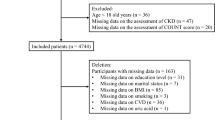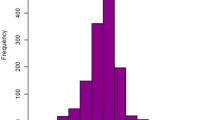Abstract
This study aimed to determine the association between diabetic complications and the nutritional index at the first hospital visit in untreated patients with diabetes. Two hundred and four patients with untreated type 2 diabetes were enrolled in the present study. Nutrition-related risks were assessed using the Geriatric Nutritional Risk Index (GNRI). The patients were divided into the following three subgroups: major/moderate risk, low risk, and no risk. Intergroup comparisons of clinical characteristics were carried out. The risk of complications related to diabetes was associated with the GNRI. The major/moderate-risk group (GNRI < 92) had a high risk for diabetic retinopathy, diabetic nephropathy, and diabetic foot, while the low-risk group (GNRI of 92 to ≤ 98) had a high risk for diabetic nephropathy only. The odds ratio of diabetic retinopathy for a major/moderate risk was 17.6. The odds ratio of diabetic nephropathy for a major/moderate risk was 16.7. Nutritional assessment at the first hospital visit using the GNRI could be a simple and useful tool for predicting the risk of diabetic complications in untreated patients with diabetes.

Similar content being viewed by others
References
IDF Diabetes Atlas 10th Edition 2021. https://www.diabetesatlas.org. Accessed 6 Dec 2021.
Ministry of Health Labour and Welfare. https://www.mhlw.go.jp/bunya/kenkou/eiyou/h28-houkoku.html (in Japanese). Accessed 8 Aug 2018
Harris MI, Klein R, Welborn TA, et al. Onset of NIDDM occurs at least 4–7 yr before clinical diagnosis. Diabetes Care. 1992;15:815–9.
Harris MI. Undiagnosed NIDDM: clinical and public health issues. Diabetes Care. 1993;16:642–52.
Araki E, Goto A, Kondo T, et al. Japanese clinical practice guideline for diabetes 2019. Diabetol Int. 2020;11:165–223.
Bouillanne O, Morineau G, Dupont C, et al. Geriatric nutritional risk index: a new index for evaluating at-risk elderly medical patients. Am J Clin Nutr. 2005;82:777–83.
Kanda Y. Investigation of the freely available easy-to-use software ‘EZR’ for medical statistics. Bone Marrow Transpl. 2013;48:452–8.
Francis NK, Pawar HS, Mitra A, et al. Rising trend of diabetes mellitus amongst the undernourished: state-of-the-art review. Diabetes Metab Syndr Suppl. 2017;1:169–74.
Kinugasa Y, Kato M, Sugihara S, et al. Geriatric nutritional risk index predicts functional dependency and mortality in patients with heart failure with preserved ejection fraction. Cir J. 2013;77:705–11.
Kobayashi I, Ishimura E, Kato Y, et al. Geriatric nutritional risk index, a simplified nutritional screening index, is a significant predictor of mortality in chronic dialysis patients. Nephrol Dial Transpl. 2010;25:3361–5.
Gau BR, Chen HY, Hung SY, et al. The impact of nutritional status on treatment outcomes of patients with limb-threatening diabetic foot ulcers. J Diabetes Complic. 2016;30:138–42.
Kimura Y, Kimura N, Akazawa M. Increased nutrition-related risk as an independent predictor of the incidence of hypoglycemia in the hospitalized older individuals with type 2 diabetes: a single-center cohort study. Diabetol Int. 2021;12:420–9.
Naber TH, de Bree A, Schermer TR, et al. Specificity of indexes of malnutrition when applied to apparently healthy people: the effect of age. Am J Clin Nutr. 1997;65:1721–5.
Apelgren KN, Rombeau JL, Twomey PL, et al. Comparison of nutritional indices and outcome in critically ill patients. Crit Care Med. 1982;10:305–7.
Corti MC, Guralnik JM, Salive ME, et al. Serum albumin level and physical disability as predictors of mortality in older persons. JAMA. 1994;272:1036–42.
Antonelli Incalzi R, Landi F, Pagano F, et al. Changes in nutritional status during the hospital stay: a predictor of long-term survival. Aging. 1998;10:490–6.
De Lima JJ, da Fonseca JA, Godoy AD. Baseline variables associated with early death and extended survival on dialysis. Ren Fail. 1998;20:581–7.
Reuben DB, Keeler E, Seeman TE, et al. Development of a method to identify seniors at high risk for high hospital utilization. Med Care. 2002;40:782–93.
Ballmer PE. Causes and mechanisms of hypoalbuminaemia. Clin Nutr. 2001;20:271–3.
Obeid A, Su D, Patel SN, et al. Outcomes of eyes lost to follow-up with proliferative diabetic retinopathy that received panretinal photocoagulation versus intravitreal anti-vascular endothelial growth factor. Ophthalmology. 2019;126:407–13.
Yamada K, Furuya R, Takita T, et al. Simplified nutritional screening tools for patients on maintenance hemodialysis. Am J Clin Nutr. 2008;87:106–13.
Acknowledgements
We thank Ellen Knapp, PhD, from Edanz (https://jp.edanz.com/ac) for editing a draft of this manuscript.
Funding
The authors received no financial support for this study.
Author information
Authors and Affiliations
Contributions
SH participated in the design of the study, analyzed data, and wrote the manuscript. MH, SI, RH, MK, and YN participated in the design of the study, and contributed to the writing and editing of the manuscript. YT, AI, and MM collected data, and contributed to the writing and editing of the manuscript. All authors approved the final version of the manuscript.
Corresponding author
Ethics declarations
Conflict of interest
The authors declare no conflict of interest.
Human rights statement and informed consent
All procedures followed were in accordance with the ethical standards of the responsible committee on human experimentation (institutional and national) and with the Helsinki Declaration of 1964 and later revisions. The study protocol was approved by the Ethics Committee of Kagoshima City Hospital (approval no: 2019-46, approval date: 20 November 2019). Because of the retrospective observational design, written informed consent was not obtained from the participants, although it was obtained via the opt-out method through the website of the institution.
Additional information
Publisher's Note
Springer Nature remains neutral with regard to jurisdictional claims in published maps and institutional affiliations.
About this article
Cite this article
Horinouchi, S., Harada, M., Ikeda, S. et al. Relationship between diabetic complications and the nutritional index in untreated diabetes. Diabetol Int 14, 58–64 (2023). https://doi.org/10.1007/s13340-022-00595-w
Received:
Accepted:
Published:
Issue Date:
DOI: https://doi.org/10.1007/s13340-022-00595-w




